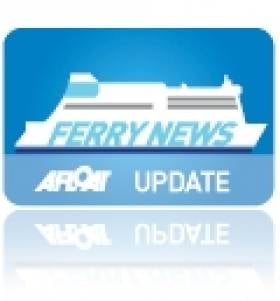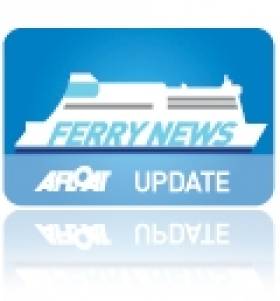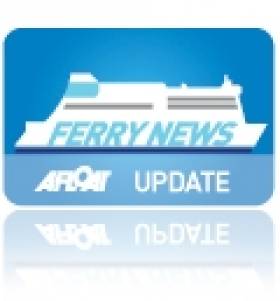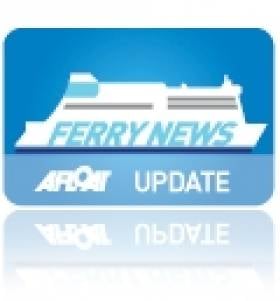Displaying items by tag: P&O Express
P&O Ferries Not to Charter Fastcraft Express in 2016
#P&OexpressCharter – P&O Ferries have confirmed with Afloat.ie that the operator is not renewing the charter of the fastcraft Express for the 2016 season, writes Jehan Ashmore.
For the last decade the 868 passenger /195 car fastcraft P&O Express has been in service on the Larne-Troon route. The seasonal-only (March-October) route operates to a schedule of two sailings departing each port.
Below is a statement issued by P&O Ferries.
We have given notice to the owners that we will not extend the existing charter arrangements of the craft after completion of the present season's service. As a business, P&O Ferries continually monitors and reviews its fleet to ensure it provides the best vessel for a given route.
Since chartering the Express in 2000, the economics of operating this fastcraft have changed and we are now looking for the best vessel to service the route. P&O Ferries is in the process of evaluating alternative tonnage for the Larne-Troon route for 2016 and we will update our staff and in turn our customers when we are in a position to do so.
Afloat.ie adds that prior to the introduction of P&O Express on the 2 hour 15 minute North Channel route, the 1998 built InCat 91m series craft was launched onto the English Channel in 2000.
In April 2005 she was transferred to the North Channel where she also operated on the Larne-Cairnryan. This shorter 2 hour route is currently served by pair of conventional ro-pax ferries.
As previously reported, the decision not to hire the 5,902 tons Express next year has impacted Isle of Man Steam Packet sailings for the 2016 TT Races. The 22.5 knot craft will not be available to the Manx operator on the Larne-Douglas route which is only operated during the annual prestigious motorcycle event.
Steam Packet Advised No P&O Fast Ferry for 2016 TT
#FerryTT2016 – According to the Isle of Man Steam Packet, the P&O Express fast craft will not be joining the island operators fleet during the 2016 TT Races.
The fastcraft P&O Express has been a regular in Manx waters for Larne trips each TT, but the craft is being returned to her owners by P&O and will not be available for TT charter trips in 2016.
Finding a suitable alternative which is available for such a short lease period is proving very difficult, so the Steam Packet Company has already adjusted its TT schedules for next year to maximise capacity.
Although the loss of P&O Express means there are slightly fewer Irish sailings during TT2016, Ben-my-Chree and Manannan have already been scheduled to operate additional Belfast sailings to accommodate Irish fans heading to the races. Adding these extra Irish services for Manannan and Ben-my-Chree means the number of sailings from Heysham and Liverpool is slightly reduced.
Isle of Man Steam Packet Company Chief Executive Mark Woodward said: 'Fast craft are expensive to operate and maintain so we are not surprised that P&O has decided to return the craft. Realistically, there simply aren't many owners who are prepared to make their vessels available for just two or three weeks charter, and commit to that a year in advance. The search for vessels is further restricted because of the size constraints necessary for vessels which can operate within the limitations of the harbours we service.
'We will keep looking for a replacement charter and have already approached several companies. None at present has indicated a willingness to release vessels to us but we will keep trying. As things stand it appears highly unlikely a suitable replacement will be available and our published schedule for TT2016 assumes we will use our existing resources.'
He added: 'Our vehicle capacity at TT is significantly higher than 20 years ago and Manannan with the mezzanine deck has double the motorcycle capacity of P&O Express, which only carried around 700 of the 14,000 motorcycles transported in 2015.'
P&O Express Fast-Ferry Fresh from Overhaul
#P&Oexpress – Annual overhaul of P&O Ferries fast-ferry Express has been completed at Harland & Wolff, from where the craft departed the 225m long dry-dock of Belfast Dock yesterday, writes Jehan Ashmore.
Prior to dry-docking, the Incat 91m built craft had gone into routine winter lay-up in early October, having carried out seasonal Larne-Troon route sailings.
According to P&O Ferries, the 900 passenger / 220 car fast ferry is to resume service on the North Channel route in March 2015.
P&O also operate the year-round Larne-Cairnryan route, served by European Causeway and European Highlander. The ro-pax pair sisters had recently accommodated Stena Line passengers and freight customers where possible due to last week's suspended Belfast-Cairnryan (Loch Ryan Port) sailings.
The Stena Line service has since resumed and is running to a normal sailing schedule.
Countdown to P&O Express Scottish Service
#P&OExpress – A month to go sees the return of P&O Ferries fastcraft 'Express' service on the two-hour Larne-Troon route, which operates from 27 March to October.
The P&O Express (1998/5,902grt) accommodates more than 800 passengers and nearly 200 vehicles on the short hop across the North Channel linking Antrim and Ayrshire. The fastcraft also operates on certain sailings in tandem with ro-pax ferries running on the Larne-Cairnryan route.
On board facilities include a Fables Restaurant, the Harbour Coffee Company and for shoppers at sea, a stroll around the spacious Seashop.
Like other Irish Sea fast-ferries during the winter months, these vessels would go into 'hibernation' mode. As for the Austal built Express 91m craft completed in Fremantle, she spent several months lying in Belfast Harbour.
For further details of the P&O Express service on the Larne-Troon service click HERE.
Seasonal Start for Three In A Row
#FERRY NEWS – By this weekend three seasonal-only operated routes from the island of Ireland will have resumed service since the recent change of the clocks marking the start of summertime, writes Jehan Ashmore.
Sailings started today on Stena Line's Dun Laoghaire-Holyhead (120 minutes) fast-craft HSS Stena Explorer operated service. The central corridor route closed last September due to cost-saving measures as previously reported. For further details on sailing schedule click HERE.
The reopening of the Welsh route follows yesterday's launch of P&O Ferries fast-craft sailings to Scotland between Larne-Troon (2 hours) served by the 92m Express. She also runs additional sailings on the year-round Larne-Cairnryan route served by a pair of conventional ferry sisters. To read more information on both sailing route schedules click HERE.
The remaining route to re-open is Brittany Ferries Cork-Roscoff (14 hours) service operated by the 2,400 passenger 'flagship' Pont-Aven, which features an indoor swimming pool. Her first sailing for this year is tonight's sailing from the Breton port.
The corresponding Irish sailing departs tomorrow afternoon and the inaugural round trip is due to be completed with an arrival in France on Sunday morning. For sailing times click HERE.
Former B+I Line Freight-Ferry Bound for Turkish Breakers
#FERRY NEWS-P&O Irish Sea's Larne-Troon freight-ferry Norcape (14,087grt) departed the Co. Antrim port last week to be broken-up at ship-breakers in Aliaga, Turkey. She originally served B+I Line as the Tipperary, but her last sailings took place on the North Channel in late November, as the ageing vessel is in her fourth decade of service, writes Jehan Ashmore.
The 125-trailer capacity ro-ro was not replaced on the single-ship operated route which closed for the winter months, though sailings will resume next March by the 92m fast-ferry Express. In the meantime freight traffic will be accommodated on the companies Larne-Cairnryan service.
Yesterday morning Norcape transitted the Strait of Gibraltar having called en-route to Falmouth several days previously. She represented the last vessel to serve in Irish waters with a direct link to B+I Line, the state-owned operator which was sold in 1992 to ICG, parent company of Irish Ferries.
When she arrives in Aliagra, this is where her former P&O fleetmate European Mariner (5,897grt) was scrapped after also serving Larne-Troon sailings until last July. Norcape entered the North Channel route replacing the smaller 53-trailer capacity vessel.
Prior to then Norcape had been in laid-over in Liverpool docks when European Endeavour replaced her in February on the Dublin-Liverpool route. To read more click HERE.
Norcape's return to the Irish Sea service in 2009, reflected her original career for P&O. She was named Puma in 1979 from the Japanese shipyard at the Mitsui Engineering & SB Co Ltd, Tamano, however she was chartered to B+I Line and renamed Tipperary. To read more and to view a deck-drawing profile, click HERE.
Her career started with a new Dublin-Fleetwood route jointly operated with P&O, who contributed with a sister, the Ibex. The P&O brand name Pandoro stood for P and O Ro, their roll-on roll-off freight division. The route's UK port switched to Liverpool in 1988 with Tipperary remaining on the route until sold to North Sea Ferries in 1989 and renamed Norcape.
Before her transfer to the North Sea, Tipperary collided with the 4,674grt bulker Sumburgh Head off the entrance to Dublin Port in 1988. Incidentally the two vessels, under different names and ownership were in Dublin Port in 2010, as previously reported (with photo) click HERE.
- Ports and Shipping News
- Norcape
- P&O (Irish Sea)
- B+I Line
- European Endeavour
- Ferry news
- Irish Sea Ferries
- Irish Sea ferry news
- LarneTroon
- MV Tipperary
- Turkish shipbreakers
- P&O Express
- MV Ibex
- Pandoro
- Aliagra,Turkey
- MV Norcape
- ICG
- ICG Group
- Irish Continental Line
- North Channel ferry routes
- LarneCairnryan
- Irish Ferries
P&O Close Seasonally Operated Fast-Ferry Services
As for the remaining winter-serving fast-ferries they are Stena Line's HSS Stena Voyager (1996/ 19,638grt) between Belfast-Stranraer, in tandem with conventional ferries. Next month this route will close as the Scottish terminal relocates to a new ferryport nearby at (Loch Ryan Port) Cairnryan.
In addition two sister-ferries, which are undergoing modifications and an upgrade for their two-year charter on the North Channel, will directly replace the two-hour passage times it takes for the HSS fast-ferry and the ferries Stena Caledonia and Stena Navigator which take 2hrs 50 minutes.
With the introduction of the new tonnage to the Belfast-Cairnryan route, sailings times will be reduced to 2hrs 15mins. Ironically the new ferries which albeit will be the largest to serve on any North Channel route will actually be some 15 minutes slower on the newer-shorter distance route compared to the HSS fast-ferry operated Belfast-Stranraer sailings.
The second fast-ferry service is operated on Irish Ferries Dublin-Holyhead route using Jonathan Swift (1999/5,989grt) which is marketed as the Dublin 'Swift'. She runs year-round in addition to the cruiseferry Ulysses.
Also operating fast-ferry craft is the Isle of Man Steam Packet Company's Manannan (1998/5,029grt) but this is on the none cross-channel route between Douglas and Liverpool.
Irish Sea Cross Channel Fast-Ferry Services On Declining Trend
The third service between Belfast-Stranraer is in the hands of rivals Stena Line which maintain the HSS Stena Voyager (1996/19,638 grt) on sailings but only to around mid-November. She will be replaced by conventional sister-ships which will be introduced on the North Channel's newest port when services switch from Stranraer to a new terminal close to Cairnryan.
Finally the fourth fast-ferry is Irish Ferries marketed 'Dublin Swift' service which runs on the Dublin-Holyhead route served by Jonathan Swift (1999/5,989 grt). The craft built by Austal in Fremantle, operates alongside the conventional cruise-ferry Ulysses.
Stena Line's decision to terminate HSS Stena Explorer sailings between Dun Laoghaire-Holyhead this day last week follows fast-ferry Stena Lynx III's end-of-season Rosslare-Fishguard sailings earlier this month.
From next year, Dun Laoghaire-Holyhead sailings are to be seasonal-only and according to Stena Line they hope to resume fast-ferry sailings in April or May though no exact date has been set. Unlike the central corridor route which was entirely dependent on HSS operations, the Rosslare-Fishguard route remains operating year-round with the conventional ferry Stena Europe.
As a result of the discontinued fast-ferries, the HSS Stena Explorer is now spending a lay-up period in the Welsh port for the winter. The smaller Stena Lynx III is also 'wintering' but in on the opposite side of the Irish Sea in Dun Laoghaire, where the vessel has done so in previous years.
The lay-up of both fast-ferries in Dun Laoghaire and Holyhead is ironic considering that neither ports' are connected by the very craft that used to share sailing rosters in recent years. In addition the wintering of these catamaran craft is the first time that this has occurred since the pioneering Stena Sea Lynx fast-ferry launched such sailings in 1993.
This first 'Lynx' provided seasonal sailings on the route with conventional car-ferry Stena Hibernia, the former St. Columba, custom-built in 1977 for Sealink /British Rail. She was given a second name under Stena ownership, the Stena Adventurer and remained on the 57 nautical-mile route until replaced in 1996 by the year-round operated HSS Stena Explorer.
Apart from cross-channel fast-ferry services, the Isle of Man is served by the Isle of Man Steam Packet Co. Ltd's routes linking the islands capital Douglas with Belfast, Dublin, Heysham and Liverpool (Birkenhead) in the winter. These routes include seasonal services which are operated by a combination of conventional tonnage using Ben-My-Chree and fast-ferry Manannan (1998/5,089grt), a former US Navy vessel, to read more click HERE. For sailing schedules, vessel type deployed on route and for fares click HERE.
- Dublin Port
- Irish Ferries
- Dun Laoghaire
- Stena Europe
- Holyhead
- P&O Ferries
- Belfast Harbour
- Stena Line
- Larne
- Ports and Shipping News
- Ulysses
- P&O (Irish Sea)
- Cairnryan
- Ferry news
- Stena Explorer
- Stena Express
- FastFerries
- Cruiseferry
- Manannan
- Isle of Man Steam Packet Co.
- Stena Voyager
- Belast Port
- Isle of Man ferry services
- P&O Express
- Irish Sea fastferries
- Stena 'Lynx'
- BenMyChree
- Dublin Swift
- Stena Sea Lynx




































































